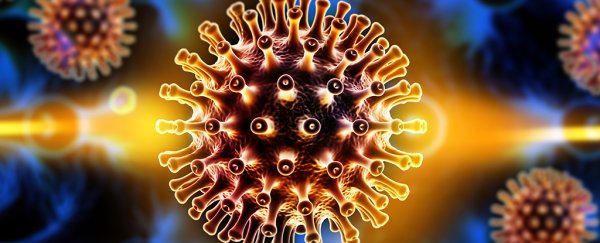Nobody knows quite when it happened. But some time in our not too distant past, a chimpanzee version of a pathogen known as simian immunodeficiency virus (SIVcpz) jumped species to infect humans.
Mutations in SIVcpz would turn it into the insidious human immunodeficiency virus (HIV-1) responsible for the global AIDS epidemic. New research suggests a common group of proteins should have protected us from infection, raising the question - how did it happen?
An international team led by researchers from the Heinrich-Heine-Universität Düsseldorf have investigated how a group of proteins called cellular cytidine deaminases (APOBEC3s or A3s in short) can offer humans protection from the virus that attacks apes.
Specifically, the scientists focussed on variants of a gene responsible for the cytidine deaminase APOBEC3H (A3H) and its role in the replication and possible transmission of the chimpanzee-specific virus.
The story of the rise of the HIV epidemic is murky up to the point when the first AIDS patients were reported in the US in the early 1980s.
While researchers can show a relationship with the simian version of the immunodeficiency virus, we can only speculate on how and when the virus leapt from apes to humans.
The transmission was more than likely passed through infected blood from meat, probably captured for food, and occurred far enough back in recent history for the virus to have had time to evolve into its current form.
Exactly why it happened at that moment – whether due to mutations or an unfortunate series of events – is still something of a mystery. But this new study could help shed some light on the question.
It's known that the A3H cytidine deaminase proteins restrict the replication of the family of viruses both HIV and SIV belong to.
Usually these viruses can retaliate with a secret weapon of their own – a protective virulence factor called vif. But it doesn't work as well against all versions of these anti-viral proteins.
What hasn't been investigated until now is whether the human form of these proteins could have stopped the ape-infecting virus dead in its tracks in people.
To determine the extent of the proteins' potential virus-busting powers, the researchers infected cultures of human kidney cells with easily-traced simian viruses from various sources. They also dosed the cells with genes to make either human or chimpanzee anti-viral proteins.
One particular human A3 protein called A3H haplotype II stood out from the crowd. It was particularly resistant to the virus's vif, allowing it to sidestep the defence and rip into the SIV's genes.
Turning to data from the Great Ape Genome Project, it was found that the chimpanzee version of A3H was less diverse than the human one.
What's more, further experiments showed vif from chimpanzee and gorilla SIV could still interfere with chimpanzee A3H.
Taken together, it makes a compelling case for the hypothesis that humans evolved a solid defence against SIV.
That might go some way in explaining why in spite of living side by side with populations of great apes for so long, the leap of SIV to HIV was a significant recent event. But why did it happen at all?
Diversity can swing both ways. While humans clearly have evolved some remarkable versions of APOBEC that offer protection from SIVcpz, it's likely that some individuals could lack that protection, or possess a weak or unstable version.
Scientists will be adding this puzzle piece to the collection, as future research continues to look at the relationship between cytidine deaminase and HIV - and it could help finally provide some answers.
This research was published in PLOS Pathogens.
